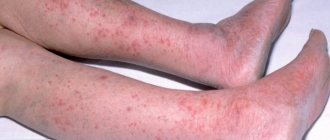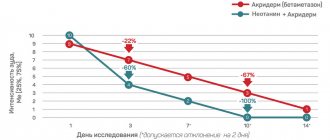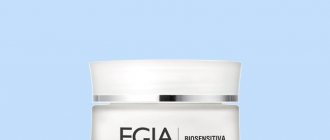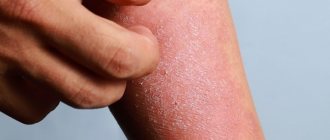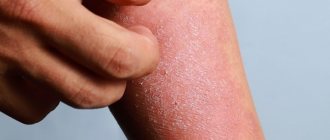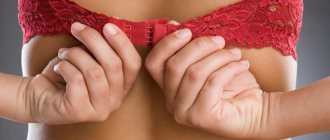Causes of weeping dermatitis
The causes of weeping dermatitis are divided into several points: distant, close, obligate, selective factors.
Remote factors causing the development of the disease:
- Hereditary factor - dermatitis in infants in 40% of manifestations, occurs due to allergies of one or both parents;
- Predisposition – having once contracted any form of weeping dermatitis, 50% of patients remain sensitive to the disease;
- Low immunity;
- Acute and chronic diseases of internal organs;
Related factors that can trigger the development of the disease:
- Psychological illnesses, prolonged stress, nervousness - very often a strong nervous shock can cause a decrease in the body’s protective functions and, as a result, a decline in immunity.
- The entry of pathogenic substances into the human body - allergens, chemicals that have a detrimental effect on the skin.
- Diseases of the stomach and/or intestines - improper functioning or malfunction of these organs is the most common cause of weeping dermatitis.
Obligate factors (arising under the influence of external factors):
- Pathogenic radiation - radiation, prolonged exposure to direct sunlight;
- Overheating or, on the contrary, hypothermia of the body;
- Contact with chemicals – acid or alkali.
Selective factors:
- Allergy – food (to food or medicine);
- Allergies - to cosmetics, insect bites;
Weeping dermatitis is essentially an advanced stage of any other type of dermatitis (domestic, occupational, fungal, bacterial), in addition to the above, can occur as a result of improperly selected treatment or ignoring the disease.
Causes of diathesis in children
Diathesis in an infant on the cheeks or other parts of the body is not a specific disease, but a predisposition to the development of pathological reactions to irritants. This is considered a feature of the body that determines its reactivity. At the same time, against the background of diathesis, certain diseases may develop under the influence of unfavorable factors.
The causes of diathesis itself can be:
- unfavorable course of pregnancy;
- past infectious diseases during pregnancy;
- abuse of medications and bad habits during pregnancy;
- hypoxia or asphyxia of the fetus during childbirth;
- too little or too much birth weight;
- pathologies of the central nervous system;
- artificial feeding;
- dysbacteriosis;
- chronic diseases;
- insufficient or poor care;
- vaccination.
Symptoms of weeping dermatitis
Symptoms of the disease may vary, depending on the age of the patient.
In adults, lesions form in natural folds of the skin, on the face and neck, arms and legs. A rash and erythema (redness) with cloudy contents appear; as the disease progresses, the rash opens, forming weeping erosions.
Common symptoms can be identified for all ages: swelling and redness of the skin at the locations of the lesions, the presence of a rash with cloudy contents.
The disease is characterized by severe itching - its intensity is influenced by the severity of damage to the nerve endings located in the skin; burning and painful sensations, a feeling of dryness or tightness; in addition, a person experiences emotional discomfort, since dermatitis has an unpleasant appearance.
Weeping dermatitis, if not properly treated, can have complications - damage to large areas of the skin, discharge of purulent contents (in cases of infection), and in rare cases, sepsis (blood poisoning) is possible.
You can see what weeping dermatitis looks like in the photo section.
Features of the course at different ages
There are several age groups, in each of them the disease occurs in a unique way.
Early childhood age (up to 3 years)
Skin lesions in babies appear in certain places. This is the face, the inner surface of the folds at the knees and elbows. The child is restless, sleeps poorly, and is capricious with food. The sores may become weeping. Possible low-grade fever.
Middle childhood
New locations of affected areas are being added. These are the hands and neck. Lots of weeping areas which leave dark areas after therapy.
Puberty
Weeping dermatitis at this age is characterized by unpredictability. Sudden remissions and exacerbations. Associated with changes in hormonal levels. With relapses, the area of the affected areas increases.
Adulthood
Localization of affected areas - limbs, folds, face and cervical segments.
Weeping dermatitis in a child
The occurrence of weeping dermatitis in children is due to the characteristics of the skin; at an early age, the skin does not have the same protective forces as the skin of an adult and is therefore more susceptible to the influence of pathogenic factors. The second reason may be weak immunity; children suffer from respiratory diseases more often than adults, and are more susceptible to the negative effects of external factors than adults.
Signs of the disease in children may vary depending on the age of the child:
Weeping dermatitis in infants often occurs on the bends of the elbows, knees and face, and very rarely occurs on other areas of the skin. Small cracks and ulcers may appear on the dermis; after a few days, crusts form on the affected areas.
In children over three years of age, lesions are localized on the hands, elbows, knees and neck. The skin in the affected areas is inflamed - swollen and acquires a bright red color, cracks and ulcers form, and the course of the disease is long. Subsequently, the skin at the former sites of outbreaks thickens and differs from healthy skin in a dark shade.
In adolescents, the disease proceeds in the same way as in children over three years of age, the only difference is the spontaneous course; there may be a sharp development or an independent decline in symptoms. With a sharp exacerbation of the disease, lesions can occupy large segments of the skin.
In the photo section, you can see what weeping dermatitis looks like in children.
Diagnosis and treatment of diathesis
The doctor determines how to treat diathesis on the cheeks of a child depending on the diagnosis performed. It includes a general urine test, general and biochemical blood tests, an immunological examination, and a stool test for dysbacteriosis. In case of lymphatic-hypoplastic diathesis, additional examinations are required: radiography of the respiratory organs, ultrasound of the liver, lymph nodes, spleen and adrenal glands.
How to treat diathesis in children under one year of age and older:
- Follow the diet and feeding schedule prescribed by your doctor.
- Introduce complementary foods no earlier than 6 months.
- Limit consumption of cow's milk.
- Enrich your diet with vitamins.
- Use prescribed medications: antihistamines, absorbents, vitamins, antipruritics.
As a local treatment, an ointment made according to the original recipe “PsorMak” is used. It does not contain hormones or other harmful components, and contains only natural ingredients that are gentle on the skin.
If in childhood a child undergoes a course of effective treatment for diathesis, then he has every chance of not encountering complications and being absolutely healthy in adulthood. Here it is important to contact a specialist in time. The PsorMak clinic practices an individual approach to the treatment of each patient, developing not only a treatment regimen, but also a diet, as well as a prevention program.
Contact us through the form on the website or by calling +7 (495) 150-15-14. We will help you form a correct understanding of the disease itself and its treatment at all stages.
Treatment of weeping dermatitis
Before starting treatment, it is necessary to conduct a diagnosis. Diagnosis is very important, since weeping dermatitis has a similar clinical picture to eczema; this is usually not difficult for a specialist, but for an accurate diagnosis, the specialist conducts the following studies:
- Scraping - to exclude other skin diseases and identify the possible causative agent of the disease;
- Tests to identify allergies and the source of allergies;
- A general blood and urine test is used to determine the cause of dermatitis and identify concomitant diseases.
Often, treatment involves complex therapy, which is aimed at eliminating the cause of weeping dermatitis and relieving the symptoms characteristic of it.
- Antihistamines (anti-allergic) drugs to relieve itching and swelling of tissues;
- Sometimes sorbents may be indicated (if dermatitis occurs due to allergies);
- Prebiotics to normalize intestinal microflora;
- Antibiotics - in case of secondary infection (when scratching, often in children)
- Local preparations for eliminating the inflammatory process, relieving the sensation of itching and for rapid tissue regeneration; a popular drug that copes with these purposes is Losterin.
- Antiseptic solutions are used to treat lesions when opening pustules (rashes).
- Severe itching can cause sleep disturbances and affect mental health, in these cases sedatives are indicated.
In addition to medications, it is recommended to follow a diet; this is one of the factors contributing to a rapid recovery. The diet involves eliminating foods that can cause allergic reactions (citrus fruits, nuts, honey, etc.).
For weeping dermatitis in infants, special attention is paid to correcting nutrition and following the mother’s diet if she is breastfeeding.
When weeping dermatitis passes into the chronic stage, medications are indicated to raise and strengthen the immune system.
Self-medication in this case is unacceptable, especially in relation to the treatment of children. The doctor prescribes medications based on test results and taking into account the characteristics of the body.
Skin care
In order to prevent an increase in the area of development of weeping dermatitis, various treatment preparations are used. For purulent discharge, 3% hydrogen peroxide can be used for cleansing, followed by drying the surface, then treated with brilliant green (green in common parlance).
This prevents infections from scratching. Hormonal ointments are prescribed - Akriderm, Flucinar, Sinaflan and others. They relieve swelling and reduce the reaction to allergens. Basic hygiene is definitely important. If we are talking about a child, daily bathing in medicinal solutions is mandatory.
Treatment of weeping dermatitis with folk remedies
Traditional medicine has many recipes to combat various dermatological pathologies. Methods of therapy may include tinctures, lotions, ointments, etc., based on herbs or other natural ingredients, but these remedies are ineffective or not effective at all. Herbal medicine can relieve some symptoms, but will not have a detrimental effect on the cause of dermatitis, and in some cases it will worsen the disease. Some traditional medicines can be used as an addition to the main treatment and should only be reported to a doctor. You should not prescribe any folk remedies yourself, especially if a child needs help.
Elimination of inflammation
As previously mentioned, ointments with hormonal components can be used topically. Antibiotics are indicated for skin infections. If there is general inflammation of the skin, the optimal use of non-steroidal anti-inflammatory drugs.
Antiallergic measures
Allergic weeping dermatitis requires special treatment. In such cases, there is a set of actions at work:
- cleansing the body - carried out in order to remove toxins, sorbents are used (activated carbon, polyphepam, cleansing enemas);
- drug suppression of the allergen - antihistamines, in modern medicine they try to use those that do not have a pronounced sedative effect (Claritin);
- diet (the basis of the fight against allergies, will be discussed later).
Traditional methods of treatment
When diagnosed with weeping dermatitis, different treatments are used in both adults and children. Traditional medicine occupies not the last place. There are many known herbs that have a beneficial effect on the condition of the skin. As a rule, it is used topically, as baths, poultices, and compresses. It is distinguished by the absence of contraindications even for the youngest patients. Decoctions are prepared from chamomile, celandine, calendula, and oak bark. They have the property of drying the skin, cleansing the skin, and preventing inflammation.
Cooking method
- pour the prepared mixture, in the amount of two glasses, into a saucepan;
- pour one liter of cold water, put on fire;
- bring to a boil and simmer over low heat for 30 minutes;
- pour into a thermos or wrap it warm and let it brew for 3 hours.
It is important to treat weeping dermatitis in infants with baths. An infusion of herbs is added during bathing. The procedure should not last less than half an hour. Children tolerate this procedure exceptionally well and their skin tone improves significantly.
In adults, lotions applied to the affected area are effective. Relieves itching, soothes, disinfects, and alleviates general condition.
Various soothing teas are used to relieve neurological symptoms. There are fees that are safe even for children. In pharmacies, for example, they sell soothing “Bunny” tea. For adults, lemon balm or an infusion of valerian root helps well.
Treatment of weeping dermatitis with Losterin
Improper skin care for dermatological diseases slows down recovery, so it is important to choose products suitable for problem skin that do not dry out, but at the same time cleanse. A common product is Losterin gel for showering or Losterin cream for skin care. Thanks to its composition, it protects the skin from dryness and cracks, helps reduce flaking and has a regenerating effect. Used for the treatment and prevention of weeping dermatitis.
Proper nutrition
Rational food intake is the basis of treatment of any dermatitis. This is especially true if you have to identify a food allergen. The principles of nutrition are simple:
- fractional meals (at least five times a day);
- water regime (at least 1.5 liters per day);
- limiting the caloric content of dishes;
- refusal of fried, spicy, fatty, smoked foods;
- food only at home;
- avoiding allergic foods.
There is a certain group of products that those who have weeping allergic dermatitis have to avoid:
- roast;
- spicy;
- smoked;
- fat;
- seasonings;
- high-fat dairy products;
- poultry meat;
- red berries;
- red fruits;
- red vegetables.
Several types of diets have been developed to help identify the allergen that causes weeping dermatitis. The most famous of them are elimination and rotation diets.
Elimination diet
The best way to independently identify foods that are allergens. It consists of gradually introducing different foods into the diet in cycles of three days. The beginning of the diet is water with crackers. After three days, meat is added and observation is carried out. If the body does not react, another product is added. In case of an aggressive response, the product is excluded.
Rotation diet
The name speaks for itself. Rotation - exchange. The diet contains four types of products - meat, vegetables, fruits and cereals. Every day the set should be different. When a food reaction to one of the groups is detected, each element is included one by one in other sets to specify the allergen.
Even on a diet you can cook delicious dishes; I offer some recipes below.
Steamed fish and potato casserole
You will need 200 grams of river fish, 200 grams of potatoes, 200 grams of broccoli. The fish is cleaned of skin and entrails and cut into thin layers. The potatoes are pre-soaked and washed. Also cut into thin layers. Broccoli is washed and chopped. A layer of potatoes, a layer of fish, and a layer of broccoli are placed in the mold. Stew in a double boiler.
Cream soup
For a diet for dermatitis you will need 200 grams of rabbit fillet, 100 grams of potatoes, 50 grams of carrots, 50 grams of broccoli, 50 grams of hard cheese, with a fat content of no more than 30%. Boil the rabbit and drain the broth. Cook vegetables separately. Grind the boiled rabbit with vegetables in a blender and put on fire in clean water until it boils. Grate the cheese into boiling water and leave to simmer for 10 minutes. Can be served with croutons.
Prevention of weeping dermatitis
It is easier to prevent any disease than to treat it, tinea versicolor is no exception, in order to avoid the development of the disease you should:
- Adhere to the rules of proper nutrition - to prevent diseases of the stomach and intestines;
- Treat acute and chronic diseases - they are often the main cause of reduced immunity;
- Maintain immunity, especially after illnesses, in the autumn-spring period, after long-term use of strong medications;
- For people prone to allergies, exclude allergens;
- Avoid stress, maintain psychological health, and consult a specialist if necessary.
If dermatitis does appear, then for a quick recovery and to prevent recurrence of the disease, you should:
- Follow the recommendations of your doctor, do not interrupt or stop treatment without consulting a doctor;
- Compliance with hygiene rules, proper treatment of affected skin areas;
- Avoid sources that provoke allergies.
Exclude pathogenic factors.
If symptoms indicating weeping dermatitis appear, you should immediately consult a doctor, this will allow you to start treatment on time, which will have a beneficial effect on the duration of therapy and reduce the risk of developing negative consequences and relapses.
Diet
Diathesis in children responds well to treatment if the recommended diet is followed.
During breastfeeding, the baby's mother should adhere to it. Allergenic foods (sweets, citrus fruits, eggs, honey, etc.) are excluded. During the introduction of complementary foods, in order to avoid the development of diathesis, the baby’s skin reactions to the new product should be monitored, and if signs of illness appear, exclude it for three to five months, until the next attempt. After the introduction of complementary foods, the basis of the menu should be cereals, lean meat and fish, vegetables and fruits. The consumption of sweets and foods high in food additives should be limited as much as possible. Contact us!
Specialists at the PsorMak Skin Diseases Center have been successfully treating diathesis in children for many years. Contact us for an initial consultation, our doctors will help you develop a complete understanding of how to properly treat the disease in the acute stage (with skin rashes). In addition, we will help you create a dietary diet and suggest what other measures to correct the child’s lifestyle should be taken to improve his health and effectively combat the disease. Make an appointment by calling +7 (495) 150-15-14,
Symptoms of diaper rash in newborns
The main symptoms of diaper rash in newborns appear depending on the stage of the disease. So, there are three degrees of pathology.
The first stage is characterized by slight hyperemia of the skin. At the same time, its integrity is not violated.
The second stage, as a rule, manifests itself in the form of bright red eroded areas with multiple microcracks. Sometimes pustules and other rashes appear. At this stage, it is necessary to be wary and begin appropriate treatment.
The third stage is the most difficult. Pathological areas have pronounced hyperemia, weeping cracks and even detachment of the epidermis. At this stage, the baby can easily become infected with fungi or bacteria with the further development of microbial eczema. Inflammatory lesions in the second and third stages are accompanied by pain, itching, burning and significantly affect the baby’s well-being. He is constantly restless and cries. The child may suffer from fever, deterioration of sleep and appetite.
Diaper rash in newborn boys
As a rule, diaper rash in newborn boys is no different from that which occurs in girls. The places of their manifestation are the same. So, often areas of weeping appear in the groin area, in the axillary folds, on the legs, arms and neck.
When the first symptoms appear, treatment should be started immediately, regardless of what gender the patient is. After all, this pathology appears the same way. It is also possible to prevent the development of inflammation of the skin. To do this, it is necessary to carry out all preventive measures. Change diapers more often, treat the baby’s skin and let it “breathe” as much as possible.
Diaper rash in newborns can occur for various reasons. Even in cases where the child is carefully cared for. After all, changing foods changes the functioning of the intestines, new bacteria appear and therefore this pathology can develop. No matter how expensive and good diapers are, they cannot save you from inflammation of the skin.
Diaper rash in newborn girls
Diaper rash develops in newborn girls due to poor care. After all, many mothers, when purchasing super-class diapers, think that they can save them from many problems. In fact, everything is not like that. Even despite the high degree of absorption, moisture remains. This leads to the development of this disease. You need to change the diaper often. It's best to let your skin breathe and not wear it all the time.
It is also necessary to monitor the baby’s nutrition. Changing products also changes the condition of the stool. Thus, new bacteria appear, which, when reacting with urine, turn into ammonia. Chemical exposure to a baby’s skin is unacceptable. Therefore, it is still worth introducing complementary foods carefully. A young mother must also take care of her own health, because the food she eats also affects the child’s body.
It is important not to start the development of wet areas. At the first stage, the simplest hygiene procedures can help. In later stages it will be necessary to treat with serious medications.
Diaper rash in newborns in the groin
Diaper rash often appears in the groin of newborns, because this is the most common place for infection to spread. This area contains a large amount of fat deposits. It is because of them that the skin rubs against each other, resulting in areas of weeping.
If the damage is minor, then it will not require special treatment. Ointments or creams are not entirely suitable for a baby’s skin. Because they will not be able to breathe under their layer. It is necessary to make sure that the skin breathes. This is especially important after feeding and swaddling. In this case, baths of string and chamomile will help perfectly.
These herbs are great for rubbing reddened areas. To carry out this process you will have to use cotton swabs. After which it is recommended to apply a protective ointment, for example, zinc, to the skin. It can save the skin from irritation and friction. If the inflammation does not go away, then baths of a light pink solution of potassium permanganate come to the rescue. It is advisable to add a decoction of tannin or oak bark to them.
It is important to wash things with special children's products and be sure to rinse them. After bathing the baby, pat dry with a napkin or towel. And you shouldn’t forget about daily air baths.
Diaper rash on the butt of a newborn
Diaper rash occurs on the bottom of a newborn quite often. Because this is where a large accumulation of moisture is located. Constantly wearing a diaper leads to unpleasant phenomena.
To carry out high-quality prevention, it is worth paying more attention to the hygiene of the child. So, the diaper should be changed often, not every hour, but still. In addition, there is no need to hope that an expensive diaper can save you from all troubles. All the same, no matter what its degree of absorption, the moisture remains. In a warm and humid place, bacteria develop much faster and thereby lead to the development of this pathology.
It is always necessary to monitor the condition of the child’s skin. It is necessary to make special baths from chamomile decoction. In more serious cases, resort to the help of potassium permanganate. There are many methods to get rid of diaper rash in newborns. The most basic of them is the ability to obtain air. Therefore, there is no need to wear a diaper all the time.
Diaper rash on the neck of newborns
Weeping areas on the neck are not so common. The main place of development has always been the groin area. After all, it is there that there is a constant accumulation of moisture due to wearing a diaper.
Why do they appear on the neck? In fact, everything is very simple. Larger babies are susceptible to this phenomenon. The fact is that there are quite a lot of folds on the child’s body, and it is in them that areas of weeping are formed. Friction of the skin against each other leads to this phenomenon. Moreover, if the treatment process is not started in time, the condition may worsen. As a rule, cracks and even purulent inflammations appear.
There is no need to worry; it is important to start eliminating redness of the skin in time. First of all, you need to include baths using chamomile decoction in your daily hygiene procedures. A weak solution of potassium permanganate will also cope perfectly with the problem of redness. In addition, the baby’s skin should always be wiped and baby cream should be used in places where inflammation may occur.
Diaper rash under the arms of a newborn
Why do areas of weeping appear under the armpits of a newborn and how to deal with this phenomenon? In fact, they can appear at any time. Sometimes even compliance with all preventive measures cannot protect the baby from the harmful effects of redness of the skin.
Under the arms, this phenomenon occurs due to the constant friction of the skin against each other. As you know, the most common places for the development of this pathology are skin folds. What to do in this case? It is necessary to carry out a number of preventive measures. It is advisable to include baths with a weak solution of potassium permanganate in hygiene procedures. Chamomile infusions should not be ignored either. Areas that are prone to redness need to be treated in a special way.
In addition, if diaper rash does occur in newborns, you should try to remove it using more gentle methods. If you have severe redness, you cannot do without consulting a doctor and using medications.
Weeping diaper rash in newborns
Weeping diaper rash occurs in newborns at more severe stages. In this case, it is necessary to use only medications. It’s just worth noting that they should be non-greasy. Under no circumstances should you treat weeping inflammations with oils or ointments. They cover the damaged area with a film and prevent healing.
For several days, lotions should be applied to wet surfaces. They need to be made from a 1-2% tannin solution, 0.25% silver nitrate solution and 0.1% rivanol solution. Only the attending physician can prescribe these medications! You cannot resort to such therapy on your own!
After the weeping disappears, zinc paste is applied. An emulsion with bactericidal substances has also proven itself well. It is important that the baby receives adequate nutrition during treatment. Under no circumstances should you do anything yourself.
Severe diaper rash in newborns
What are the dangers of severe diaper rash in newborns, and why does it occur? The fact is that in the later stages they are difficult to treat. You need to think about this problem at the moment when inflammation appears. The third stage is the most difficult in itself.
Purulent inflammation occurs on the skin, and detachment of the epidermis is observed. All this is very serious and under no circumstances should the development of a severe stage be allowed. Timely prevention and elimination of the problem at the initial stages will save the situation.
In the final stages, weeping wounds may appear. In this case, it is necessary to resort to the help of medications. These should be non-greasy products. The fact is that ointments and oils cover the inflammation with a special film, which slows down the entire healing process. Under no circumstances should you start treatment on your own. Here everything is done under the supervision of the attending physician.
How to treat diaper rash in newborns?
First of all, it is worth noting that under no circumstances should you use disposable napkins and other tricks. At this stage, comprehensive treatment should be carried out.
So, even the most ordinary creams and liniments are perfect. It is important that they are not greasy. In this case, a film may form on the pathological area, which complicates the healing process.
Lotions should be made, preferably made from a 1-2% tannin solution. You can wipe the child with a damp cloth, which has previously been soaked in chamomile decoction. It is important to pat your baby dry after any bathing or drying procedure!
In general, it is better to use complex treatment. So, it is advisable to bathe the baby in a weak solution of potassium permanganate and chamomile. Naturally, the result should be secured with special creams and ointments. But under no circumstances should they be used without the knowledge of a doctor.
Bepanten
Bepanthen is an excellent preventative and therapeutic agent. It is used both to prevent inflammation and to treat chafed and irritated skin. In addition, it effectively fights inflammation, abrasions and diaper dermatitis. Therefore, its spectrum of action is quite wide.
The main active ingredient of the drug is provitamin B5. It is able to accelerate mitosis, as well as regulate cellular metabolic processes and increase the strength of collagen fibers.
The cream is quickly absorbed and thereby contributes to the effective replenishment of endogenous pantothenic acid reserves. Bepanten has excellent moisturizing and regenerating properties. The cream is highly safe and has no side effects. That is why it is recommended for children to use it.
The product must be applied after every diaper change. This is naturally done on cleansed and dry skin.
Baneocin
Baneocin is used only in severe stages. Because this powder fights complex inflammatory processes.
Baneocin is not only effective, but also affordable compared to other ointments and creams. The powder can be used to treat wounds and is done painlessly. For a small child this is very important, because he already experiences unpleasant sensations.
It is worth noting that this product is supplied both in the form of liniments and powder. Baneocin has a good anti-inflammatory effect. The powder can be applied to the treated wound and no discomfort will be observed. If the condition of weeping is satisfactory, then one use of the product will be enough. When the process is difficult, you need to apply the powder after each swaddling.
If we talk about the ointment, it has the same properties. Apply it after each diaper change to clean, cleansed skin.
Fukortsin
An excellent antifungal and antiseptic drug is fucorcin. This solution is for external use only. It is actively used to treat abrasions, scratches, as well as cracks and erosions of the skin.
Fucorcin should only be applied with a cotton swab or swab. The affected areas are wiped 2-5 times a day. To enhance the effect of the drug, the treated area should be soaked in cream for newborns after drying.
The medicine is really good, there is no need to doubt its effectiveness. It should be noted that it does not require application after every diaper change. To notice a positive effect, 2-5 times of application to the skin is enough.
Some doctors recommend using the drug for this pathology of candidal origin. But this must be done with extreme caution. In general, fucorcin is an excellent solution for combating major skin problems.
